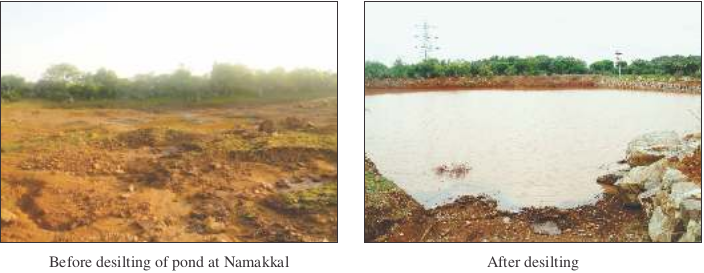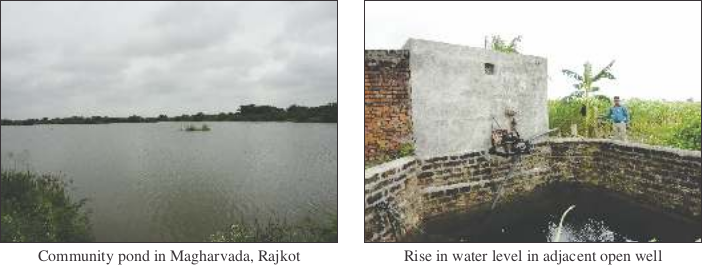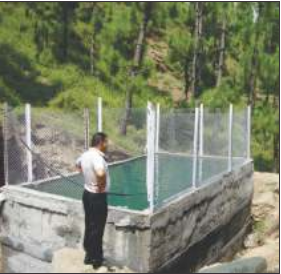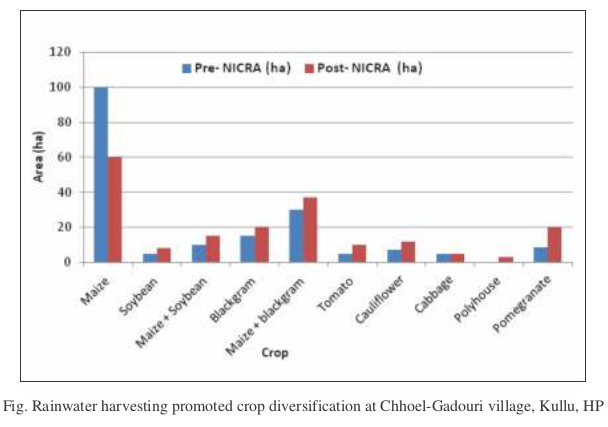Community tanks / ponds as a means of augmentation and management of village level water resources
Community tanks / ponds as a means of augmentation and management of village level water resources
Climate vulnerability
Drought
Existing practice
Large number of tanks with substantial water storage capacity constructed long ago have become defunct due to neglect, non-maintenance and silting up. Due to neglect of community tanks, surplus rainfall (runoff) during kharif is not stored properly and used. Hence, due to prolonged dry spells at critical stages, crop failures are experienced in some years or production is seriously affected. Rainfed crops in rabi, experience soil moisture deficit which results in low productivity. Kharif crops suffer due to prolonged dry spells sometimes leading to crop failures. Farmers face these situations in identified villages in Namakkal (TN), Kurnool (AP), Rajkot (GJ) and Kullu (HP).
Resilient practice / technology
One of the first works accomplished in the NICRA project villages was to identify these structures to carry out desiltation of tanks with farmers' participation. The rich silt deposited in these structures was used by farmers for spreading in the fields, wherever necessary, to improve the water holding capacity of soils. This intervention helped in increasing the surface water resource availability, increased the ground water recharge observed through water table measurements in wells located nearer to the tanks.
At Vadavathur and Jambumadai, Namakkal, village tanks are predominant in these parts of Tamil Nadu since a long time, but have bean discontinued due to individual irrigation facilities such as wells / canal irrigation. Revival of this traditional practice of water storage in a large community/village based tanks was considered as one option for augmentation of water resources. The villages identified for interventions under NICRA were surveyed and suitable plan was prepared.
Impact of desilted community pond
Desiltation and renovation of three community ponds were done with community participation in ponds namely Senguttai, Aayiramkuttai and Periyakalingikuttai covering a surface area of 1045, 5035 & 3605 m2 and having storage capacity of 5735, 23000 & 16500 m3, respectively. An additional increase in water storage of 36617 cu.m was created through intervention after desilting and renovation in two phases during the year 2012 and 2013.
- Senguttai pond helped in recharging of 18 open wells and 11 bore wells; as a result crop was cultivated in 13.6 ha
- Aayiramkuttai pond helped in recharging of 45 open wells and 112 bore wells; as a result crop was cultivated in 73.6 ha
- Periyakalingikuttai pond helped in recharging of 45 open wells and 156 bore wells; as a result crop was cultivated in 137.5 ha area
Increase in storage capacity by desilting of community pond at Vadavathur, Namakkal
| Name of the Pond | Dimensions (Before intervention, m) | Dimensions (After intervention, m) | Major Cultivated Crops (Before) | Major Cultivated Crops(After) |
|---|---|---|---|---|
| Senguttai | 36 x 26 x 3.65 | 38 x 28 x 5.4 | Onion and Sorghum | Onion , Groundnut and Sorghum |
| Aayiramkuttai | 30 x 22 x 1.85 | 92 x 55 x 4.5 | Onion and Sorghum | Onion, Paddy and Groundnut |
| Periyakalingikuttai | 49 x 22 x 3.65 | 112 x 32 x 4.5 | Onion and Sorghum | Onion , Groundnut and Sorghum |

Yagantipalle village of Kurnool is one of the drought prone districts in Andhra Pradesh. The village on an average receives an annual rainfall of 546 mm. Water scarcity, poor soil health and frequent droughts are the major climatic constraints faced by the farming community. About 200 tube wells were non-functional due to low water table during post-monsoon period. Hence, the village committee proposed to desilt the existing Burrakunta tank for deepening and use of tank silt to improve soil physical properties and fertility in farmers' fields.
Desilting was taken up during July 2012 and 1260 m3 silt was excavated in Yagantipalle village. Deepening of tank increased additional water storage capacity and observed that water table raised by 12 ft in tube wells during November 2012. Silt was applied to 15 acres covering 10 farmers. Cotton and castor were cultivated in silt applied soils. About 15 to 18% yield increase was observed in silt applied plots over the check due to high fertility status of silt.
Rajkot district in Gujarat receives low, uneven and erratic rainfall. Cotton and groundnut are the major crops during kharif and both crops are affected by drought/dry spells which generally occur during mid July to August. During kharif 2011, nearly 600 ha of cultivable land in the village was badly affected by drought. The extent of yield loss was about 50-80% in cotton and 80-100% in groundnut.
Rainwater harvesting and groundwater recharging were given priority in Magharvada village, Rajkot. Desilting and deepening of two community ponds increased storage capacity upto 37000 m3 and 30000 m3, respectively in convergence with the irrigation department of the State government. From community pond, supplemental irrigation to groundnut crop was applied by 10 farmers and covered an area of 20 ha. In rabi season, 15 farmers took up wheat crop in 20 ha area by lift irrigation of water from community pond. The average ground water table has risen by 3 to 4 m as compared to previous years.

Smaller community tanks suitable for hill agriculture in Kullu, HP
Kullu district of Himachal Pradesh is known for apple production. During early nineties apple along with major cereals like wheat and maize were grown by the farmers of Chhoel Gadouri, the selected village of NICRA. However, due to warmer temperature, shifting of apple cultivation from lower valley areas to upper areas owing to non-fulfillment of chilling requirement of the crop is happening. Drought is the other major constraint in the village. Climate variability in terms of historical rainfall trend over last three decades indicated that dry spells of 10-20 days are increasing particularly during kharif season. Therefore, in order to mitigate the drought to some extent, major focus was on water harvesting for life saving irrigation through micro-irrigation system.

Keeping in view the fragile eco-system of the region, a series of inter-linked water storage tanks (one tank of 50 m3 capacity and three tanks of 20 m3 each) were constructed under the project in Chhoel Gadouri village. In addition, farmers were motivated to construct water harvesting structures through awareness cum training programme which resulted in construction of 4 water storage tanks of 80 m3 capacity by dovetailing with developmental schemes (MGNREGS). This intervention helped the farmers to cultivate vegetable crops. These tanks were able to provide irrigation to transplanted tomatoes, cauliflower and cabbage during summer and newly planted pomegranate plants. Through this intervention, there is a significant change in the cropping pattern as the area under vegetable crops like tomato, pea, spinach, okra, garlic, cauliflower and cabbage has increased, replacing area under cereals.

Scope for upscaling
Large community ponds in central and southern states and community ponds of smaller size in hilly areas can be up-scaled in convergence with MGNREGS / IWMP / NMSA.
Source: Smart practices and Technologies for Climate Resilient Agriculture
Last Modified : 2/13/2020
This topic provides information about Crop diversi...
This topic defines about the Enhancing resilience ...
This topic provides information about Captive rear...
This topic provides information about Drought tole...
